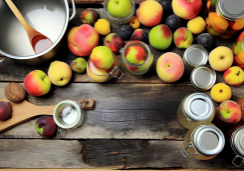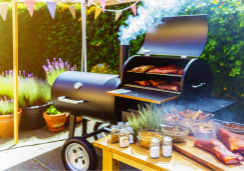100% Beginner's Guide to Home-Smoked Meats
In the age where cloud smoking is a metaphor for data storage rather than a culinary technique, you're seeking the tangy secrets of traditional smoke and char. You've decided it's time to embrace the art of home-smoked meats, and you're in the right place to begin.
As you venture into this smoky realm, it's essential to understand that the path to succulent briskets and fall-off-the-bone ribs is both an art and a science. You'll need to select the right equipment and understand the nuances of different woods and their flavors.
Preparing your meats with the proper brines and rubs is just the start; mastering the slow dance of temperature and smoke is where the true skill lies. You're about to embark on a journey that will transform your backyard barbecues into a savory spectacle, and it all starts with the first billow of smoke from your new smoker.
So, what's the first step you'll take to unlock the smoldering potential of your culinary creations?
Selecting the Right Smoker
When diving into the world of home-smoked meats, choosing a smoker that fits your needs is crucial for both control and consistency.
You might start with a gas grill or kettle grills you can use for both grilling and smoking. These options allow for the use of wood chips or chunks to imbue your meats with that sought-after smoky flavor.
However, if you're looking for more precision, consider pellet grills or electric smokers. They're user-friendly and offer better temperature control, vital for perfecting your smoked delicacies.
For those of you ready to take it a step further, an offset smoker or a smoker grill combo could be your ticket to smoky nirvana. These types of smokers excel in long-term smoking sessions, giving you the versatility to switch between high-heat grilling and low-and-slow smoking. Remember, proper ventilation is key in any type of smoker to ensure a steady flow of smoke and prevent bitter flavors.
Whether you're adding wood to charcoal, using wood chips, or loading up wood chunks, the smoker you choose will be the vessel for your culinary adventures. So, select wisely and prepare for a mouthwatering journey.
Understanding Wood Types
Having selected the ideal smoker, it's time to explore the diverse world of wood types and their unique impact on your home-smoked meats. Each type of wood imbues a distinct flavor and aroma, essential to mastering the art of smoking.
Hardwoods such as hickory and oak are the stalwarts of smoking, delivering a robust, traditional smoky taste that's perfect for Smoke Meat aficionados seeking that classic flavor. Fruitwoods, including apple and cherry, sway on the sweeter side, imparting a delicate nuance that can elevate the taste of your smoked dishes.
When choosing the best wood for smoking, consider the meat's compatibility with the wood's intensity. Mesquite's boldness complements beef's richness, while pecan's milder touch is a match made in heaven for poultry. The smoking process is as much about personal preference as it's about technique, so don't shy away from experimenting with various wood types to discover what tantalizes your taste buds the most.
Whether you're using traditional smokers or pellet smokers, the selection of Wood Pellets or wood chunks can make or break the flavor profile of your smoked creation. Remember, balance is key; too much smoke can overshadow the meat's natural flavors. So, use wood wisely and watch as your home-smoked meats become the talk of the town.
Preparing Your Meats
Before you let your meats bask in the smoky embrace of your chosen wood, it's crucial to prep them properly to ensure the flavors fully penetrate and the texture turns out perfectly. Preparing your meats is your first step to delicious home-smoked dishes. Start by marinating your cuts to enhance their flavor; this could be a succulent brisket or pork butt, waiting to be transformed by smoke.
Make sure to thaw your meats completely before smoking. This not only ensures an even cooking process but also allows your dry rub or marinade to adhere better. Speaking of rubs, applying a generous layer of your chosen spices will form a flavorful crust that's irresistible. Don't overlook the fat cap; it protects the meat during smoking and adds moisture.
When it comes to meats to smoke, choices like smoked pork and smoked turkey breast are popular for good reason. They absorb those woodsy aromas beautifully, making your efforts worth it. Always monitor the temperature range with a reliable thermometer, crucial for meats like chicken that must be cooked thoroughly. If you're short on time, consider smoking pre-cooked meats, as they require less attention to internal temperatures and reduce overall cooking time.
Mastering Smoking Techniques
Now that your meats are marinated and ready, it's time to focus on honing your smoking skills to achieve that perfect balance of flavor and tenderness. Remember, low and slow smoking is the key to unlocking the full potential of your smoked meat. If it's your first time, you'll want to stick closely to a temperature guide to ensure success.
To master smoking techniques:
- Use indirect heat to cook the meat evenly without burning. This means setting up your grill or smoker so the meat isn't directly over the fire.
- Add wood chunks, chips, or pellets periodically to maintain a consistent smoke flavor. Each type offers a different burn rate and intensity of flavor.
- Keep an eye on the cooking process—adjust vents as needed to control the temperature and smoke density.
- Experiment with flavors by choosing woods that complement your meat, like hickory for pork or cherry for chicken.
Throughout the process, maintain patience and a watchful eye. Your goal is to gently coax the meat to its succulent best, enveloped in a rich, smoky aroma. With practice, you'll find the sweet spot where technique meets taste, and your home-smoked meats will be the talk of the table.
Maintaining Ideal Temperatures
To unlock the full potential of your smoked meats, diligently monitor your grill's temperature, aiming to keep it within the sweet spot of 200 to 250 degrees Fahrenheit. This range is pivotal for the low and slow cooking approach that imbues your meat with that irresistible smokiness.
Secure a quality thermometer to keep an eye on the heat and smoke levels in your cooking chamber. Better yet, consider a Bluetooth thermometer for real-time monitoring without constant grill-side vigilance.
Your smoking prowess hinges on mastering the art of temperature control. The ambient temperature can be a wildcard, affecting your grill's interior warmth. Be ready to make adjustments, especially when the weather decides to throw you a curveball.
For charcoal grills, refreshing your fuel source—adding new charcoal and wood every couple of hours—is essential to maintain consistent heat. Gas grill aficionados aren't off the hook either; remember to replace wood chunks as they burn out.
The goal is to maintain a steady, low-temperature smoking environment. Ventilation is your ally here, allowing you to fine-tune the airflow and thus the internal temperature. Experiment with opening or closing vents and adding fuel incrementally to find that perfect equilibrium for mouthwatering results.
Frequently Asked Questions
What Is the Easiest Meat to Smoke for a Beginner?
You'll find pork shoulders forgiving with heat control, ideal for learning smoking temperatures. Start with a simple brine recipe; wood chips will infuse a delicious flavor profile, yielding that coveted smoke ring after resting.
How to Smoke Meat for Dummies?
You'll master smoking meat by choosing the right cuts, learning temperature control, and picking wood for flavor. Marinate for taste, cure for preservation, and aim for that perfect smoke ring and moisture retention. Enjoy!
What Kind of Smoker Should a Beginner Get?
You should start with an electric or charcoal smoker, considering your budget, space, and portability needs. Choose durable materials for ease of maintenance, and master temperature control to distinguish the flavor differences.
How Do You Start a Smoker for Beginners?
To start your smoker, choose your wood, prepare the smoker, and carefully control the temperature. Adjust vents for smoke flow, place meat strategically, and follow seasoning tips. Always maintain the fire and prioritize safety.
Conclusion
You've got the tools to smoke meats like a pro now! Choose your smoker wisely, match the wood to your meat's flavor profile, prep meticulously, and master those smoking techniques.
Keep a keen eye on temperatures for the perfect cook. Dive in, get smoky, and watch as your backyard transforms into a meat lover's paradise.
Happy smoking!










